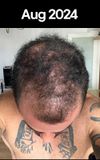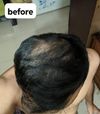community 7 years on oral finasteride/topical minoxidil/ket (Pics included). Losing ground... what more can I do to stop the loss and gain more hair?
A user's journey to try and stop their hair loss, including the use of oral finasteride, topical minoxidil, ketoconazole shampoo, Cynatine Keratin supplements, and The Ordinary's Multi-Peptide Serum for Hair Density; and advice from other users regarding trying dutasteride, oral minoxidil, and lifestyle changes.







